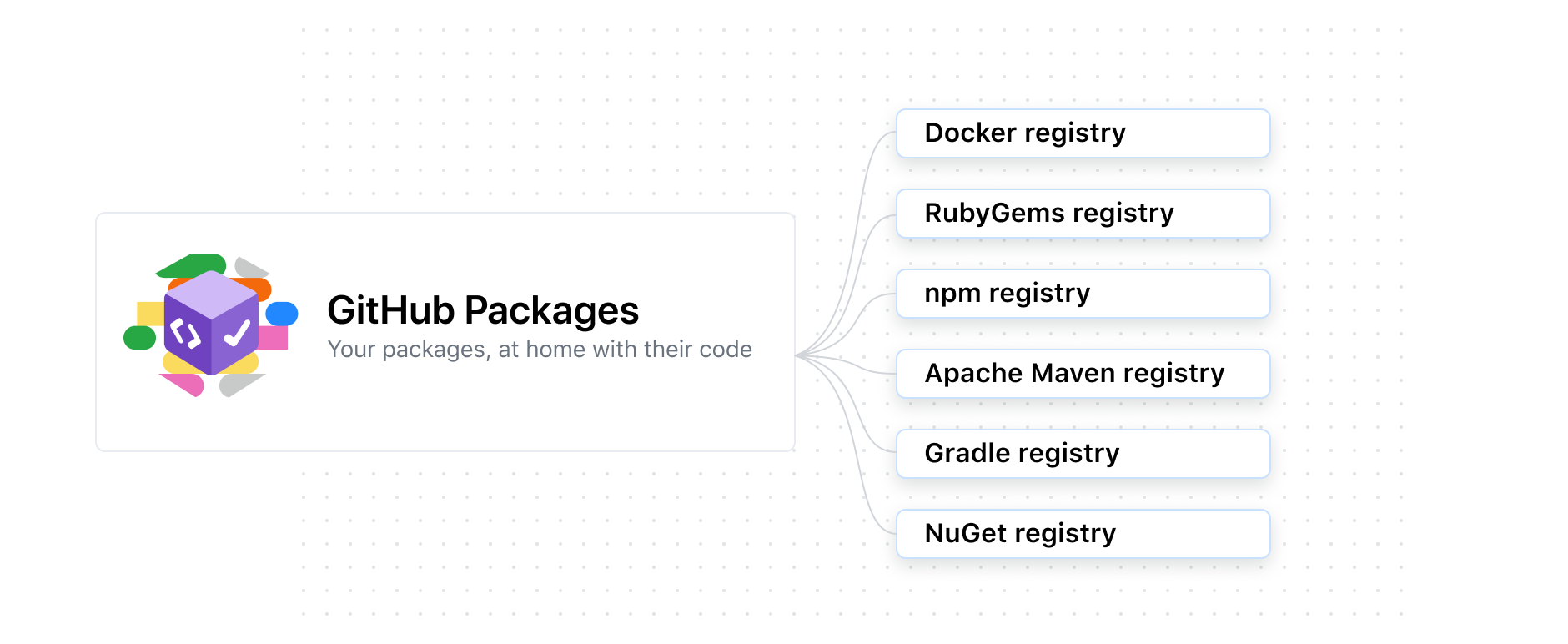Note: GitHub Packages is currently in beta for GitHub Enterprise Server 2.22. To join the beta for your GitHub Enterprise Server instance, use the sign-up form.
About GitHub Packages
GitHub Packages is a platform for hosting and managing packages, including containers and other dependencies. GitHub Packages combines your source code and packages in one place to provide integrated permissions management and billing, so you can centralize your software development on GitHub Enterprise Server.
You can integrate GitHub Packages with GitHub Enterprise Server APIs, GitHub Actions, and webhooks to create an end-to-end DevOps workflow that includes your code, CI, and deployment solutions.
GitHub Packages offers different package registries for commonly used package managers, such as npm, RubyGems, Apache Maven, Gradle, Docker, and NuGet. For more information on the different package registries that GitHub Packages supports, see "Working with a GitHub Packages registry."

You can view a package's README, as well as metadata such as licensing, download statistics, version history, and more on GitHub Enterprise Server. For more information, see "Viewing packages."
Overview of package permissions and visibility
| Permissions | Each package inherits the permissions of the repository where the package is hosted. For example, anyone with read permissions for a repository can install a package as a dependency in a project, and anyone with write permissions can publish a new package version. |
| Visibility | You can publish packages in a public repository (public packages) to share with everyone on your enterprise, or in a private repository (private packages) to share with collaborators or an organization. |
For more information, see "About permissions for GitHub Packages."
Supported clients and formats
GitHub Packages uses the native package tooling commands you're already familiar with to publish and install package versions.
Support for package registries
| Language | Description | Package format | Package client |
|---|---|---|---|
| JavaScript | Node package manager | package.json | npm |
| Ruby | RubyGems package manager | Gemfile | gem |
| Java | Apache Maven project management and comprehension tool | pom.xml | mvn |
| Java | Gradle build automation tool for Java | build.gradle or build.gradle.kts | gradle |
| .NET | NuGet package management for .NET | nupkg | dotnet CLI |
| N/A | Docker container management | Dockerfile | Docker |
For more information about configuring your package client for use with GitHub Packages, see "Working with a GitHub Packages registry."
Authenticating to GitHub Packages
You need an access token to publish, install, and delete packages.
You can use a personal access token (PAT) to authenticate to GitHub Packages or the GitHub Enterprise Server API. When you create a personal access token, you can assign the token different scopes depending on your needs. For more information about packages-related scopes for a PAT, see "About permissions for GitHub Packages."
To authenticate to a GitHub Packages registry within a GitHub Actions workflow, you can use:
GITHUB_TOKENto publish packages associated with the workflow repository.- a PAT to install packages associated with other private repositories (which
GITHUB_TOKENcan't access).
For more information about GITHUB_TOKEN used in GitHub Actions workflows, see "Authentication in a workflow."
Managing packages
You can delete a version of a private package in the GitHub Enterprise Server user interface or using the GraphQL API.
When you use the GraphQL API to query and delete private packages, you must use the same token you use to authenticate to GitHub Packages. For more information, see "Deleting a package" and "Forming calls with GraphQL."
You can configure webhooks to subscribe to package-related events, such as when a package is published or updated. For more information, see the "package webhook event."
Contacting support
If you need support for GitHub Packages, please contact your site administrators.